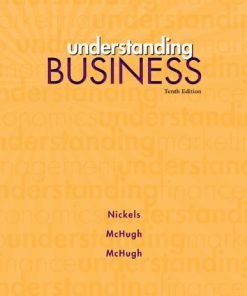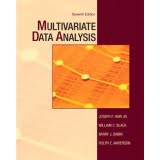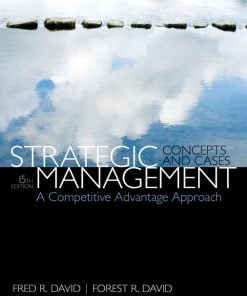Solutions Manual for Reliability Engineering by Singiresu S. Rao 0136015727
$35.00 Original price was: $35.00.$26.50Current price is: $26.50.
Solutions Manual for Reliability Engineering by Singiresu S. Rao 0136015727
*** YOU ARE BUYING the Solution Manual for Reliability Engineering by Singiresu S. Rao 0136015727
Product details:
- ISBN-10 : 9780136015727
- ISBN-13 : 978-0136015727
- Author: Rao
Reliability Engineering is intended for use as an introduction to reliability engineering, including the aspects analysis, design, testing, production and quality control of engineering components and systems.
Numerous analytical and numerical examples and problems are used to illustrate the principles and concepts. Expanded explanations of the fundamental concepts are given throughout the book, with emphasis on the physical significance of the ideas. The mathematical background necessary in the area of probability and statistics is covered briefly to make the presentation complete and self-contained. Solving probability and reliability problems using MATLAB and Excel is also presented.
Table of contents:
- Chapter 1 Introduction
- What You Will Learn
- 1.1 Uncertainty in Engineering
- 1.2 Definition of Reliability
- 1.3 Importance of Reliability
- 1.4 Pattern of Failures
- 1.4.1 Component Failures
- Solution:
- Solution:
- 1.4.2 Mechanical and Structural Failures
- 1.5 Factor of Safety and Reliability
- 1.6 Reliability Analysis Procedure
- 1.7 Reliability Management
- 1.8 History of Reliability Engineering
- 1.9 Some Examples of System Failures
- 1.9.1 Collapse of Tacoma Narrows Bridge in 1940
- 1.9.2 Crash of El Al Boeing 747-200 in 1992
- 1.9.3 Disaster of Space Shuttle Challenger in 1986
- 1.9.4 Chernobyl Nuclear Power Plant Accident in 1986
- 1.9.5 Mississippi River Bridge 9340 Collapse in 2007
- 1.9.6 Fukushima Nuclear Accident in 2011
- 1.9.7 Explosion of the First Jet Airplane Comet
- 1.9.8 Breaking of the Tanker S. S. Schenectady
- 1.9.9 Crash of the Supersonic Aircraft Concorde
- 1.10 Numerical Solutions Using MATLAB and Excel
- Solution:
- Solution:
- 1.11 Reliability Literature
- References and Bibliography
- Review Questions
- Problems
- Solutions using MATLAB and Excel
- Chapter 2 Basic Probability Theory
- What You Will Learn
- 2.1 Introduction
- 2.2 Mutually Exclusive Events
- 2.3 Set Theory
- 2.4 Sample Points and Sample Space
- Solution:
- Solution:
- 2.5 Definition of Probability
- 2.6 Laws of Probability
- 2.6.1 Union and Intersection of Two Events
- 2.6.2 Mutually Exclusive Events
- Solution:
- Solution:
- Solution:
- 2.6.3 Complementary Events
- Solution:
- Solution:
- Solution:
- 2.6.4 Conditional Probability
- Solution:
- 2.6.5 Statistically Independent Events
- 2.6.6 General Laws
- 2.7 Total Probability Theorem
- Solution:
- Solution:
- Solution:
- Solution:
- Solution:
- 2.8 Bayes’ Rule
- Solution:
- Solution:
- References and Bibliography
- Review Questions
- Problems
- Chapter 3 Random Variables and Probability Distributions
- What You Will Learn
- 3.1 Introduction
- 3.2 Probability Mass Function for Discrete Random Variables
- 3.3 Cumulative Distribution Function for Discrete Random Variables
- Solution:
- Solution:
- 3.4 Probability Density Function for Continuous Random Variables
- Solution:
- Solution:
- Solution:
- 3.5 Mean, Mode, and Median
- 3.5.1 Mean
- Discrete Case.
- Continuous Case.
- Solution:
- Solution:
- 3.5.2 Mode
- Discrete Case.
- Continuous Case.
- 3.5.3 Median
- Discrete Case.
- Continuous Case.
- Solution:
- 3.6 Standard Deviation and Skewness Coefficient
- 3.6.1 Standard Deviation
- Solution:
- Solution:
- Solution:
- 3.6.2 Skewness Coefficient
- Solution:
- 3.7 Moments of Random Variables
- 3.8 Importance of Moment Functions—Chebyshev Inequality
- Solution:
- 3.9 Jointly Distributed Random Variables
- 3.9.1 Joint Density and Distribution Functions
- 3.9.2 Obtaining the Marginal or Individual Density Function from the Joint Density Function
- Solution:
- 3.10 Moments of Jointly Distributed Random Variables
- 3.11 Probability Distributions
- 3.11.1 Binomial Distribution
- Solution:
- Solution:
- 3.11.2 Poisson Distribution
- Solution:
- Solution:
- 3.11.3 Normal Distribution
- Standard Normal Distribution.
- Solution:
- Solution:
- 3.11.3 Lognormal Distribution
- Solution:
- Solution:
- 3.12 Central Limit Theorem
- 3.13 Normal Approximation to Binomial Distribution
- 3.14 Numerical Solutions Using MATLAB and Excel
- 3.14.1 MATLAB Functions for Discrete and Continuous Probability Distributions
- Solution:
- Solution:
- Solution:
- Solution:
- Solution:
- 3.14.2 Random Numbers, Fitting Data to Distributions and Confidence Intervals9
- Solution:
- Solution:
- Solution:
- 3.14.3 Solutions using Excel
- Solution:
- Solution:
- References and Bibliography
- Review Questions
- Problems
- MATLAB and Excel Problems
- Chapter 4 Extremal Distributions
- What You Will Learn
- 4.1 Introduction
- 4.2 Extreme Value Distributions in Terms of Parent Distribution
- 4.3 Asymptotic Distributions
- 4.4 Type-I Asymptotic Distributions
- 4.4.1 Maximum Value
- 4.4.2 Smallest Value
- 4.5 Type-II Asymptotic Distributions
- 4.5.1 Maximum Value
- 4.5.2 Smallest Value
- 4.6 Type-III Asymptotic Distributions
- 4.6.1 Maximum Value
- 4.6.2 Smallest Value
- 4.7 Return Period
- Solution:
- 4.8 Characteristic Value
- 4.9 Fitting Extremal Distributions to Experimental Data
- 4.9.1 Least-squares Fit
- Solution:
- 4.10 Generalized Extreme Value Distribution
- 4.11 Numerical Solutions Using MATLAB and Excel
- Solution:
- Solution:
- Solution:
- Solution:
- Solution:
- References and Bibliography
- Review Questions
- Problems
- MATLAB and Excel Problems
- Chapter 5 Functions of Random Variables
- What You Will Learn
- 5.1 Introduction
- 5.2 Functions of a Single Random Variable
- Solution:
- Solution:
- Solution:
- Solution:
- 5.3 Functions of Two Random Variables
- 5.3.1 Sum of Two Random Variables
- Solution:
- Solution:
- 5.3.2 Product of Two Random Variables
- 5.3.3 Quotient of Two Random Variables
- Solution:
- 5.4 Function of Several Random Variables
- 5.5 Moments of a Function of Several Random Variables
- 5.5.1 Mean and Variance of a Linear Function
- 5.5.2 Mean and Variance of Sum of Two Random Variables
- 5.5.3 Mean and Variance of Product of Two Random Variables
- 5.5.4 Mean and Variance of Quotient of Two Random Variables
- 5.5.5 Mean and Variance of a General Nonlinear Function of Several Random Variables
- Solution:
- 5.6 Moment-Generating Function
- 5.6.1 Moments of Normally Distributed Variables
- Solution:
- 5.7 Functions of Several Random Variables
- Solution:
- 5.8 Numerical Solutions Using MATLAB
- Solution:
- Solution:
- References and Bibliography
- Review Questions
- Problems
- MATLAB Problems
- Chapter 6 Time-Dependent Reliability of Components and Systems
- What You Will Learn
- 6.1 Introduction
- 6.2 Failure Rate versus Time Curve
- 6.3 Reliability and Hazard Functions
- Solution:
- 6.4 Modeling of Failure Rates
- 6.5 Estimation of Failure Rate from Empirical Data
- Solution:
- 6.6 Mean Time to Failure (MTTF)
- Solution:
- 6.7 Reliability and Hazard Functions for Different Distributions
- 6.7.1 Exponential Distribution
- Solution:
- Solution:
- 6.7.2 Normal Distribution
- Solution:
- 6.7.3 Lognormal Distribution
- Solution:
- Solution:
- 6.7.4 Weibull Distribution
- Solution:
- Solution:
- Solution:
- 6.7.5 Gamma Distribution
- 6.7.6 Rayleigh Distribution
- Solution:
- 6.7.7 Uniform Distribution
- 6.8 Expected Residual Life
- Solution:
- Solution:
- 6.9 Series Systems
- 6.9.1 Failure Rate of the System
- 6.9.2 MTBF of the System
- Solution:
- 6.10 Parallel Systems
- Solution:
- 6.10.1 Failure Rate of the System
- 6.10.2 MTBF of the System
- 6.11 (k, n) Systems
- 6.11.1 MTBF of the System
- 6.12 Mixed Series and Parallel Systems
- 6.13 Complex Systems
- 6.13.1 Enumeration Method
- Solution:
- 6.13.2 Conditional Probability Method
- Solution:
- 6.13.3 Cut-set Method
- Solution:
- 6.14 Reliability Enhancement
- 6.14.1 Series System
- With no constraint.
- With constraint.
- 6.14.2 Parallel System
- With no constraint.
- With constraint.
- 6.15 Reliability Allocation—AGREE Method
- Solution:
- 6.16 Numerical Solutions Using MATLAB and Excel
- Solution:
- Solution:
- Solution:
- References and Bibliography
- Review Questions
- Problems
- MATLAB and Excel Problems
- Chapter 7 Modeling of Geometry, Material Strength, and Loads
- What You Will Learn
- 7.1 Introduction
- 7.2 Modeling of Geometry
- 7.2.1 Tolerances on Finished Metal Products
- 7.2.2 Assembly of Components
- Solution:
- Solution:
- 7.3 Modeling of Material Strength
- 7.3.1 Statistics of Elastic Properties
- 7.3.2 Statistical Models for Material Strength
- 7.3.3 Model for Brittle Materials
- 7.3.4 Model for Plastic Materials
- 7.3.5 Model for Fiber Bundles
- 7.4 Fatigue Strength
- 7.4.1 Constant-Amplitude Fatigue Strength
- 7.4.2 Variable-Amplitude Fatigue Strength
- 7.5 Modeling of Loads
- 7.5.1 Introduction
- 7.5.2 Dead Loads
- 7.5.3 Live Loads
- Solution:
- 7.5.4 Wind Loads
- Solution:
- Solution:
- Variation with Height.
- Solution:
- Determination of Wind Load.
- 7.5.5 Earthquake Loads
- Response Spectrum.
- Solution:
- Earthquake Loads.
- Power Spectrum of Ground Acceleration.
- 7.6 Numerical Solutions Using MATLAB and Excel
- Solution:
- Solution:
- References and Bibliography
- Review Questions
- Problems
- MATLAB and Excel Problems
- Chapter 8 Strength-Based Reliability
- What You Will Learn
- 8.1 Introduction
- 8.2 General Expression for Reliability
- 8.3 Expression for Probability of Failure
- 8.4 General Interpretation of Strength and Load
- 8.5 Reliability for Known Probability Distributions of S and L
- 8.5.1 Reliability When S and L Follow Normal Distribution
- 8.5.2 Approximate Expressions of Reliability for Normal Distribution
- Solution:
- Solution:
- Solution:
- 8.5.3 Reliability When S and L Follow Lognormal Distribution
- Solution:
- 8.5.4 Reliability When S and L Follow Exponential Distribution
- Solution:
- 8.5.5 Reliability When S and L Follow Extreme Value Distributions
- 8.5.6 When S and L Follow Type-III Extremal Distributions
- 8.5.7 Reliability in Terms of Experimentally Determined Distributions of S and L
- Solution:
- 8.6 Factor of Safety Corresponding to a Given Reliability
- Solution:
- 8.7 Reliability of Systems Involving More Than Two Random Parameters
- Solution:
- Solution:
- 8.8 First-Order Second-Moment (FOSM) Method
- Solution:
- Solution:
- 8.9 Hasofer-Lind Reliability Index with Two Normally Distributed Variables
- 8.10 Hasofer-Lind Reliability Index with Several Normally Distributed Variables
- 8.11 Reliability of Weakest-Link and Fail-Safe Systems
- 8.11.1 Introduction
- 8.11.2 Reliability of the Fundamental Problem
- Bounds on the Probability of Failure.
- Solution:
- 8.11.3 Reliability of Weakest-Link (or Series) Systems4
- Simple Bounds on the Probability of Failure.
- Ditlevsen Bounds on the Probability of Failure.
- Solution:
- 8.11.4 Reliability Analysis of Fail-Safe (or Parallel) Systems
- Probability of Failure.
- Bounds on the Probability of Failure.
- 8.12 Numerical Solutions Using MATALB and Excel
- Solution:
- Solution:
- Solution:
- Solution:
- Solution:
- Solution:
- References and Bibliography
- Review Questions
- Problems
- MATLAB and Excel Problems
- Chapter 9 Design of Mechanical Components and Systems
- What You Will Learn
- 9.1 Introduction
- 9.2 Design of Mechanical Components
- Solution:
- Solution:
- Solution:
- 9.3 Fatigue Design
- 9.3.1 Deterministic Design Procedure
- Solution:
- 9.3.2 Probabilistic Design Procedure
- Solution:
- Solution:
- 9.4 Design of Mechanical Systems
- 9.4.1 Reliability-Based Design of Gear Trains
- Introduction.
- Assumptions.
- Design Equations.
- Mean and Standard Deviations of Induced Stresses.
- Probabilistic Model.
- Design Procedure.
- Numerical Results.
- 9.5 Reliability Analysis of Mechanical Systems
- 9.5.1 Cam-Follower Systems
- Introduction.
- Kinematic Response of the Cam-Follower System.
- Mean and Standard Deviation of the Kinematic Response.
- Numerical Results.
- 9.5.2 Four-Bar Mechanisms
- Deterministic Analysis.
- Probabilistic Analysis.
- Numerical Results.
- 9.6 Numerical Solutions Using MATLAB and Excel
- Solution:
- Solution:
- References and Bibliography
- Review Questions
- Problems
- MATLAB and Excel Problems
- Chapter 10 Monte Carlo Simulation
- What You Will Learn
- 10.1 Introduction
- 10.2 Generation of Random Numbers
- 10.2.1 Generation of Random Numbers Following Standard Uniform Distribution
- 10.2.2 Random Variables with Nonuniform Distribution
- Solution:
- Solution:
- Solution:
- Solution:
- Solution:
- 10.2.3 Generation of Discrete Random Variables
- Solution:
- Solution:
- 10.3 Generation of Jointly Distributed Random Numbers
- 10.3.1 Independent Random Variables
- 10.3.2 Dependent Random Variables
- Solution:
- 10.3.3 Generation of Correlated Normal Random Variables
- Solution:
- 10.4 Computation of Reliability
- 10.4.1 Sample Size and Error in Simulation
- 10.4.2 Example: Reliability Analysis of a Straight-Line Mechanism
- 10.5 Numerical Solutions Using MATLAB and Excel
- Solution:
- Solution:
- References and Bibliography
- Review Questions
- Problems
- MATLAB and Excel Problems
- Chapter 11 Reliability-Based Optimum Design
- What You Will Learn
- 11.1 Introduction
- 11.2 Optimization Problem
- 11.3 Formulation of Optimization Problems
- 11.3.1 Reliability Allocation Problems
- Solution:
- Solution:
- Solution:
- 11.3.2 Structural and Mechanical Design Problems
- Solution:
- Solution:
- 11.4 Solution Techniques
- 11.4.1 Graphical-Optimization Method
- Solution:
- 11.4.2 Lagrange Multiplier Method
- Solution:
- Solution:
- 11.4.3 Penalty Function Method (SUMT)
- Unconstrained Minimization.
- One-dimensional Minimization.
- Solution:
- Solution:
- Deterministic Formulation.
- Probabilistic Formulation.
- 11.4.4 Dynamic Programming
- Solution:
- 11.5 Numerical Solutions Using MATLAB
- Solution:
- Solution:
- Solution:
- References and Bibliography
- Review Questions
- Problems
- MATLAB Problems
- Chapter 12 Failure Modes, Event-Tree, and Fault-Tree Analyses
- What You Will Learn
- 12.1 Introduction
- 12.2 System-Safety Analysis
- 12.3 Failure Modes and Effects Analysis (FMEA)
- 12.4 Event-Tree Analysis
- Solution:
- Solution:
- Solution:
- 12.5 Fault-Tree Analysis (FTA)
- 12.5.1 Concept
- 12.5.2 Procedure
- Solution:
- Solution:
- Solution:
- Solution:
- 12.6 Minimal Cut-Sets
- Solution:
- 12.6.1 Probability of the TOP Event
- Solution:
- Solution:
- References and Bibliography
- Review Questions
- Problems
- Chapter 13 Reliability Testing
- What You Will Learn
- 13.1 Introduction
- 13.1.1 Objectives of Reliability Tests
- 13.1.2 Details of a Reliability Test
- 13.2 Analysis of Failure Time
- 13.2.1 Analysis of Individual Failure Data
- Solution:
- 13.2.2 Analysis of Grouped Failure Data
- 13.3 Accelerated Life Testing
- 13.3.1 Testing Until Partial Failure
- 13.3.2 Magnified Loading
- 13.3.3 Sudden-death Testing
- Solution:
- 13.4 Sequential Life Testing
- 13.5 Statistical Inference and Parameter Estimation
- 13.5.1 Maximum-likelihood Method
- Solution:
- Solution:
- 13.6 Confidence Intervals
- 13.6.1 Confidence Interval on the Mean of a Normal Random Variable of Known Standard Deviation
- Solution:
- 13.6.2 Confidence Interval on the Mean of a Normal Random Variable of Unknown Standard Deviation
- Solution:
- 13.6.3 Confidence Interval on the Standard Deviation of a Normal Random Variable with Unknown Mean
- Solution:
- 13.7 Plotting of Reliability Data
- 13.7.1 Least-Squares Technique
- 13.7.2 Linear Rectification
- 13.7.3 Plotting Positions
- 13.7.4 Exponential Distribution
- Solution:
- 13.7.5 Normal Distribution
- Solution:
- 13.7.6 Lognormal Distribution
- 13.7.7 Weibull Distribution
- Solution:
- 13.8 Numerical Solutions Using MATLAB
- 13.8.1 Parameter Estimation and Confidence Intervals
- Solution:
- Solution:
- Solution:
- 13.8.2 Plotting of Data
- Solution:
- Solution:
- References and Bibliography
- Review Questions
- Problems
- MATLAB Problems
- Chapter 14 Quality Control and Reliability
- What You Will Learn
- 14.1 Introduction
- 14.2 Importance of Controlling Dimensions of Products
- Solution:
- Solution:
- 14.3 Important Discrete Probability Distributions
- 14.3.1 Binomial Distribution
- Solution:
- 14.3.2 Hypergeometric Distribution
- Solution:
- Solution:
- 14.3.3 Poisson Distribution
- Solution:
- 14.3.4 Relationship Between Poisson and Exponential Distributions
- 14.4 Six Sigma Approach and Reliability
- Solution:
- Solution:
- Solution:
- 14.5 Acceptance Sampling
- 14.6 Process Capability
- Solution:
- Solution:
- 14.7 Quality Control Charts
- 14.7.1 The p-Chart
- Solution:
- 14.7.2 The X ¯ -Chart
- Solution:
- 14.7.3 The R-Chart
- Solution:
- 14.7.4 The c-Chart
- Solution:
- 14.8 Risks
- 14.9 Operating Characteristic (OC) Curve
- 14.9.1 OC Curve
- 14.9.2 Construction of OC Curve
- Solution:
- 14.9.3 Designing a Single Sampling Plan with a Specified OC Curve
- 14.10 Taguchi Method
- 14.10.1 Basic Concept
- 14.10.2 Loss Function
- Solution:
- 14.10.3 Noise Factors
- 14.10.4 On-Line Versus Off-Line Quality Control
- 14.10.5 Three-Step Design Approach
- Concept Design.
- Parameter Design.
- Tolerance Design.
- 14.10.6 Experimental Design
- Orthogonal Arrays.
- Solution:
- 14.10.7 Signal-To-Noise Ratio
- 14.10.8 Experimental Design in the Presence of Noise Factors
- Solution:
- 14.11 Numerical Solutions Using MATLAB
- Solution:
- References and Bibliography
- Review Questions
- Problems
- MATLAB Problem
- Chapter 15 Maintainability and Availability
- What You Will Learn
- 15.1 Introduction
- 15.2 Maintainability
- 15.2.1 Overview
- 15.2.2 Preventive Maintenance
- Solution:
- Without Repair.
- With Repair.
- Solution:
- Solution:
- 15.2.3 Imperfect Maintenance
- Solution:
- 15.2.4 Repair-time Distributions
- When Time to Repair Follows Exponential Distribution.
- When Time to Repair Follows Lognormal Distribution.
- Solution:
- Solution:
- Solution:
- 15.2.5 Unrepaired Failures
- Solution:
- 15.2.6 Optimal Replacement Strategy
- 15.2.7 Spare Parts Requirement
- Solution:
- 15.3 Availability
- 15.3.1 Definitions [15.1, 15.3]
- 15.3.2 Availability Analysis
- 15.3.3 Development of the Model
- 15.3.4 Systems with a Single Component
- Solution:
- 15.3.5 Series Systems
- One Repair Person.
- Two Repair Persons.
- 15.3.6 Parallel Systems
- One Repair Person.
- Two Repair Persons.
- 15.4 Optimization Approaches
- 15.5 Numerical Solutions Using MATLAB and Excel
- Solution:
- Solution:
- References and Bibliography
- Review Questions
- Problems
- MATLAB and Excel Problems
- Chapter 16 Warranties
- What You Will Learn
- 16.1 Introduction
- 16.2 Types of Warranties
- 16.3 Warranty Costs Based on a Single Failure During the Warranty Period
- 16.3.1 Free Replacement Warranty
- Solution:
- 16.3.2 Pro-rata Warranty
- Solution:
- 16.3.3 Combined Free Replacement Warranty and Pro-rata Warranty (FRW/PRW) Policy
- Solution:
- 16.3.4 FRW Policy Equivalent to a FRW/PRW Policy
- Solution:
- 16.3.5 Lump-sum Payment Type of Warranty
- Solution:
- 16.4 Warranty Costs Considering the Time Value of Money
- 16.4.1 FRW Policy
- Solution:
- 16.4.2 PRW Policy
- Solution:
- 16.5 Warranty Reserve Fund Considering the Time Value of Money and Future Changes in the Price of the Product
- Solution:
- 16.6 Warranty Analysis Considering Multiple Failures During the Warranty Period
- 16.6.1 Renewal Process
- 16.6.2 Computation and Use of Renewal Functions
- 16.7 Optimum Warranty Period
- 16.8 Two-dimensional Warranties
- 16.9 Numerical Solutions Using MATLAB
- Solution:
- Solution:
- References and Bibliography
- Review Questions
- Problems
- MATLAB Problems
- Appendix A Standard Normal Distribution Function
- Appendix B Values of tα, n for Specific Values of α and n of t-Distribution
- Appendix C Values of χ2n, α Corresponding to Specific Values of α and n of χ2-Distribution
- Appendix D Product Liability
- D.1 Basic Concept
- D.2 Definitions
- D.3 Theories of Product Liability
- D.4 Prevention of Product Liability
- Guidelines to Prevent Design Defects
- Guidelines to Prevent Manufacturing Defects
- References and Bibliography
- Answers to Selected Problems
People also search:
reliability engineering services
reliability engineering and systems safety
site reliability engineering book pdf
Related products
Solution Manual
Solution Manual
Solution Manual for Absolute C++, 5/E 5th Edition Walter Savitch
Solution Manual
Understanding Business Nickels 10th Edition Solutions Manual
Solution Manual
Solution Manual for Introduction to Electrodynamics, 4/E 4th
Solution Manual
Solution Manual for Data Structures and Other Objects Using C++, 4/E Michael Main, Walter Savitch
Solution Manual
Solution Manual












